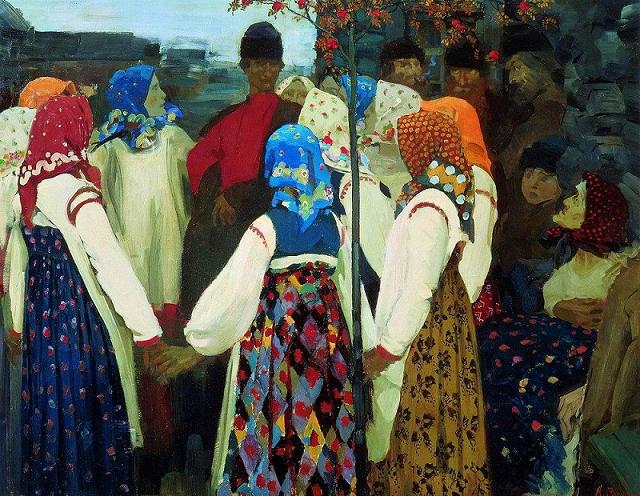Khorovod on:
[Wikipedia]
[Google]
[Amazon]
 The khorovod or horovod ( rus, хорово́д, p=xərɐˈvot, uk, хоровод, translit=khorovod or uk, коло, translit=kolo, label=none, be, карагод , bg, хоро, pl, korowód) is an East Slavic and pagan art form and one of the oldest dances of Russia with its more than 1,000 years history. It is a combination of a circle dance and
The khorovod or horovod ( rus, хорово́д, p=xərɐˈvot, uk, хоровод, translit=khorovod or uk, коло, translit=kolo, label=none, be, карагод , bg, хоро, pl, korowód) is an East Slavic and pagan art form and one of the oldest dances of Russia with its more than 1,000 years history. It is a combination of a circle dance and
Khorovod description and history
{{Circle dance Belarusian culture Circle dances Belarusian traditional dances Russian traditional dances Ukrainian folk dances
 The khorovod or horovod ( rus, хорово́д, p=xərɐˈvot, uk, хоровод, translit=khorovod or uk, коло, translit=kolo, label=none, be, карагод , bg, хоро, pl, korowód) is an East Slavic and pagan art form and one of the oldest dances of Russia with its more than 1,000 years history. It is a combination of a circle dance and
The khorovod or horovod ( rus, хорово́д, p=xərɐˈvot, uk, хоровод, translit=khorovod or uk, коло, translit=kolo, label=none, be, карагод , bg, хоро, pl, korowód) is an East Slavic and pagan art form and one of the oldest dances of Russia with its more than 1,000 years history. It is a combination of a circle dance and chorus
Chorus may refer to:
Music
* Chorus (song) or refrain, line or lines that are repeated in music or in verse
* Chorus effect, the perception of similar sounds from multiple sources as a single, richer sound
* Chorus form, song in which all verse ...
singing, similar to the choreia of ancient Greece
Ancient Greece ( el, Ἑλλάς, Hellás) was a northeastern Mediterranean civilization, existing from the Greek Dark Ages of the 12th–9th centuries BC to the end of classical antiquity ( AD 600), that comprised a loose collection of cu ...
. The dance was also known in Rus' as ''karagod'', ''tanok'' and ''krug''.
Etymology
The term ''khorovod'' probably descended from the Greek ''Choreia'' (Ancient Greek
Ancient Greek includes the forms of the Greek language used in ancient Greece and the ancient world from around 1500 BC to 300 BC. It is often roughly divided into the following periods: Mycenaean Greek (), Dark Ages (), the Archaic pe ...
: χορεία). Greek culture had a strong impact on Rus' culture. It is related to choreia (Greek circle dance), kolo dance (South Slavic circle dance in Serbia, Croatia and Bosnia), hora dance (Balkans
The Balkans ( ), also known as the Balkan Peninsula, is a geographical area in southeastern Europe with various geographical and historical definitions. The region takes its name from the Balkan Mountains that stretch throughout the who ...
), kochari ( Armenian and Azerbaijani
Azerbaijani may refer to:
* Something of, or related to Azerbaijan
* Azerbaijanis
* Azerbaijani language
See also
* Azerbaijan (disambiguation)
* Azeri (disambiguation)
* Azerbaijani cuisine
* Culture of Azerbaijan
The culture of Azerbaijan ...
folk dance).
Origin and characteristics
The most significant features of the khorovod dance is to hold hands or the little finger of the partners while dancing in a circle. The circle dance symbolised in ancient Russian culture "moving around the sun" and was a pagan rite with the meaning of unity and friendship. The female organizer or leader of the dance was called ''khorovodnitsa''.Regional difference in Russia
The khorovod dance has own characteristics in the different regions of Old Russia. In the northern Russian regions, the round dance was known for its gentle and subtle manner, while in the central Russian regions, the dance was more cheerful and lighthearted. Russian folk songs accompanied the dance. The people kicked, clapped and made quick and energetic movements. Dances insouthern Russia
Southern Russia or the South of Russia (russian: Юг России, ''Yug Rossii'') is a colloquial term for the southernmost geographic portion of European Russia generally covering the Southern Federal District and the North Caucasian Feder ...
, with its warm, mild weather, were famous for their rapid, hot-blooded movements and complex patterns, embodying strength, boundless energy and youth.
See also
* Hora (dance) * Kolo (dance) * Bulgarian dancesReferences
External links
Khorovod description and history
{{Circle dance Belarusian culture Circle dances Belarusian traditional dances Russian traditional dances Ukrainian folk dances